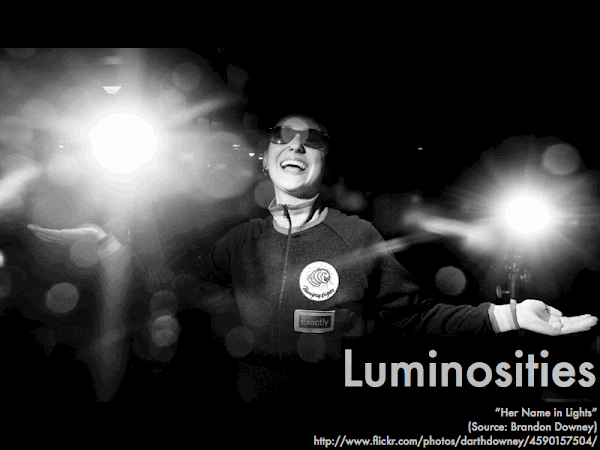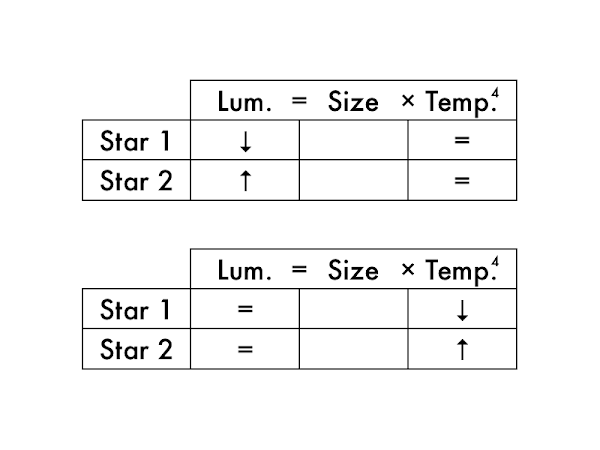Cuesta College, San Luis Obispo, CA
Students have a weekly online reading assignment (hosted by SurveyMonkey.com), where they answer questions based on reading their textbook, material covered in previous lectures, opinion questions, and/or asking (anonymous) questions or making (anonymous) comments. Full credit is given for completing the online reading assignment before next week's lecture, regardless if whether their answers are correct/incorrect. Selected results/questions/comments are addressed by the instructor at the start of the following lecture.
The following questions were asked on reading textbook chapters and previewing presentations on parallax, distance, apparent magnitude, absolute magnitude, Wien's law and the Stefan-Boltzmann law.

Selected/edited responses are given below.
Describe something you found interesting from the assigned textbook reading or presentation preview, and explain why this was personally interesting for you.
"How near by stars have a larger parallax and distant stars have a smaller parallax. The images provided really helped me make sense of it!"
"How everything is kind of backwards in astronomy, for example how the more magnitude a star has the dimmer it is. Also how if a star is a warmer color it's less hot then a cooler color star."
"How we're able to figure out so much about stars from Earth. Also I always thought the sun was the brightest star but it's not."
"How blue stars are hotter than red stars, because it makes sense when you think about fire. The reddish/yellow flames are less hot than the blue flames."
"That a star's the warmer a star gets the color shifts from red and yellow to white and blue. Red and yellow are the colors I would typically associate with the hottest stars, but it was interesting to see that it is the exact opposite."
"That we are going to learning about the different colored stars, their temperatures, and how bright/dim they get."
"That finding the size of a star depends on its luminosity, and to find this you can use math!"
"I found the relationship between luminosity, size and temperature interesting because I like math, especially when it relates to real-world examples."
"Everything about this chapter has been interesting. A little confusing, but interesting nonetheless. Stars are an incredibly fascinating and beautiful thing to learn about!"
Describe something you found confusing from the assigned textbook reading or presentation preview, and explain why this was personally confusing for you.
"I'm still not quite sure what a parallax is or how it works..."
"I found how to measure the distance of a star from Earth using parallax, to be quite interesting but just a little confusing. How does looking at the star from Earth while it's at one end of its orbit, then looking six months later tell you its distance?? I don't understand how the shift of the star in that specific amount of time, would tell you the distance."
"I think I need a little more clarification on the apparent and absolute magnitudes. Also the difference between the star sizes and their colors."
"I think the concept of parallax is interesting, but I'm a bit confused by the wording in the presentation. I understand its from two different points of view and you take it within a six months time difference but how do you know if it is closer or farther?"
"Why are brighter stars given negative numbers? Like what the heck how does that even make sense? I feel like that just makes everything way more complicated than it needs to be."
"That the lower the number, the brighter the star?"
"The magnitude scale kind of threw me off, because why is 'lots of brightness' considered a negative number. The second time I reread I just switched 'dim' for positive numbers (+6 being the dimmest shown) and 'bright' at –1!"
"I need some more help and explanation about the size of the stars and their temperatures. I kind of understand it but got a little lost."
"I found the Stefan-Boltzmann law to be confusing and hard. I'm not completely sure how to figure out all the different information. Like how to find the size from the luminosity and temperature. I get thats what you're supposed to do but I don't completely get how."
"I didn't find anything particularly confusing."
Explain how apparent magnitude and the absolute magnitude are defined differently.
"Apparent magnitude refers to how bright the star appears from Earth. However, a bright star can have a low apparent magnitude if it is very far from Earth. The absolute magnitude takes into consideration its distance, and measures how bright it would be if it were 10 parsecs away."
"Apparent magnitude is how bright the star appears from Earth, while the absolute magnitude is how bright the star appears at a standard distance of 10 parsecs."
"Apparent = 'as is.' This means that the distance you are to these stars is how you categorize their brightness. Absolute = '10 parsecs away.' This evens the scale by bringing both stars an equal distance away to see how their brightness measures side by side."
"Apparent is brightness of a star without compensating for distance while absolute compensates for distance."
"Apparent is how it appears from our view on Earth, absolute is what it actually is."
"I have no idea and need help with this."
Suppose the sun was moved to a distance of 10 parsecs away. As a result, its __________ magnitude would become dimmer.
absolute. *************** [15] apparent. ******************* [19] (Both of the above choices.) ** [2] (Neither of the above choices.) [0] (Unsure/guessing/lost/help!) [0]

(Only correct responses shown.)
1 (brightest): the sun, m = –27 [83%]
2: Canopus, m = –1 [83%]
3: Vega, m = 0 [81%]
4 (dimmest): Kapteyn's star, m = +9 [92%]
Rank the brightnesses of these stars (1 = brightest, 4 = dimmest; there are no ties), if relocated to 10 parsecs from Earth.
(Only correct responses shown.)
1 (brightest): Canopus, M = –3 [81%]
2: Vega, M = +0.5 [86%]
3: the sun, M = +5 [78%]
4 (dimmest): Kapteyn's star, M = +11 [89%]
Determine whether these stars get dimmer or brighter when relocated from their original positions to 10 parsecs from Earth.
(Only correct responses shown.)
The sun: gets dimmer [83%]
Canopus: gets brighter [75%]
Vega: gets dimmer [56%]
Kapteyn's star: gets dimmer [64%]
Rank the temperatures of these main sequence stars (1 = hottest, 4 = coolest; there are no ties).
(Only correct responses shown.)
Hottest: blue main sequence star [89%]
Second hottest: white main sequence star [81%]
Third hottest: yellow main sequence star [89%]
Coolest: red main sequence star [94%]
Rank the temperatures of these supergiant and dwarf stars (1 = hottest, 4 = coolest; there are no ties).
(Only correct responses shown.)
Hottest: blue supergiant [86%]
Second hottest: white dwarf [72%]
Third hottest: yellow supergiant [83%]
Coolest: red dwarf [86%]

dimmer. ***** [5] brighter. ************************ [24] (These stars would be the same size.) * [1] (Unsure/guessing/lost/help!) ****** [6]
Two stars (equally far away) have the same brightness, but one star is cooler, and the other star is hotter. The __________ star will be larger in size.
cooler. ********************** [22] hotter. ****** [6] (These stars would be the same size.) ** [2] (Unsure/guessing/lost/help!) ****** [6]
Ask the instructor an anonymous question, or make a comment. Selected questions/comments may be discussed in class.
"Please help!!! I am lost with this chapter with temperature/size and parallax!"
"I feel like I do understand most of these two chapters, but I think the lecture will solidify the information presented! Looking forward to lecture!"
"The lower the magnitude number, the brighter the star. Red stars are cooler, blue stars are hotter. Wtf?" (¯\_(ツ)_/¯)
"Will all these formulae be given on exams and/or in-class activities?" (No. But instead of memorizing equations, you just need to remember the logical steps used to compare stars' distances, brightnesses, sizes, and temperatures.)
"I don't understand the term 'blackbody.' It seems that they aren't black but have actual colors?" (A blackbody is a substance that doesn't have a color (either clear or black) at room temperature. If you heat it up so much that it begins to glow, then it will exhibit "blackbody radiation" (continuous spectrum light) that has a characteristic red, orange, yellow, white, or blue color. But only when it's hot.)
"I need more explanation on Stefan-Boltzman Law of stars please."
"Ok, can you talk a lot about star sizes and temperature please, I'm confusing myself."
"Will we go over and clarify how to determine the size of certain stars based on the information given like the questions above?" (Yes.)
"Why are the letters of the spectral sequence in that order? Is there meaning to it?" (No meaning (aside from whatever mnemonic you use to remember the sequence); they were presumably labeled alphabetically until they realized that sorting them by temperature will scramble the original alphabetical order.)
"The size of a star doesn't determine the temperature, the color does?" (Yes!)
"Sorry I'm legit too tired to give thoughtful answers, P-dog." ((-.-)zzz)
"Would you jump into a black hole if you had the chance?" (I would much rather watch someone else jump in. Far more entertaining.)
"What sparked your passion for astronomy? (Black holes. In the second grade I asked a University of Hawaii astronomy professor about what happens to stuff that falls into them.)
No comments:
Post a Comment